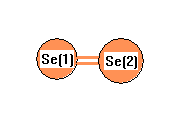Jump to
S2C1
Energy calculated at QCISD(T)/aug-cc-pVTZ
| | hartrees |
|---|
| Energy at 0K | -4800.247262 |
| Energy at 298.15K | |
| HF Energy | -4799.796205 |
| Nuclear repulsion energy | 280.481404 |
The energy at 298.15K was derived from the energy at 0K
and an integrated heat capacity that used the calculated vibrational frequencies.
Geometric Data calculated at QCISD(T)/aug-cc-pVTZ
Point Group is D∞h
Cartesians (Å)
| Atom |
x (Å) |
y (Å) |
z (Å) |
|---|
| Se1 |
0.000 |
0.000 |
1.090 |
| Se2 |
0.000 |
0.000 |
-1.090 |
Atom - Atom Distances (Å)
| |
Se1 |
Se2 |
| Se1 | | 2.1809 |
Se2 | 2.1809 | |
 More geometry information
More geometry information
Electronic energy levels
Charges, Dipole, Quadrupole and Polarizability
Jump to
S1C1
Energy calculated at QCISD(T)/aug-cc-pVTZ
| | hartrees |
|---|
| Energy at 0K | -4800.222423 |
| Energy at 298.15K | -4800.218397 |
| Nuclear repulsion energy | 277.929148 |
The energy at 298.15K was derived from the energy at 0K
and an integrated heat capacity that used the calculated vibrational frequencies.
Geometric Data calculated at QCISD(T)/aug-cc-pVTZ
Point Group is D∞h
Cartesians (Å)
| Atom |
x (Å) |
y (Å) |
z (Å) |
|---|
| Se1 |
0.000 |
0.000 |
1.100 |
| Se2 |
0.000 |
0.000 |
-1.100 |
Atom - Atom Distances (Å)
| |
Se1 |
Se2 |
| Se1 | | 2.2010 |
Se2 | 2.2010 | |
 More geometry information
More geometry information
Electronic energy levels
Charges, Dipole, Quadrupole and Polarizability
